It is what we make out of what we have, not what we are given, that separates one person from another.
– Nelson Mandela

Continued from Act 1, which you can read HERE.
Inchanga to Cato Ridge
Rory hadn’t been kidding.
He’d warned me that I’d see it coming. That before I reached it, I’d see the steady stream of runners, like ants on an escalator, switchbacking up, up, up before mercifully disappearing out of sight around the bend. And he’d warned me that this sobering sight, with 47 km in my legs, would be psychologically akin to having my heart ripped from my chest and held high in front of me, Indiana Jones-style.
The moment reminded me of that scene in Breaking Bad when Walter Heisenberg demands of his fellow meth dealer, “SAY MY NAME.”
Inchanga.
It’s the only one of the Big Five whose name alone suggests trouble. And unlike the first three, each of which exacted its pound of flesh, Inchanga isn’t happy with physical retribution—it has to play mind games with its victims too, like a cat batting around a trapped mouse. As it turns out, I was lucky to have glimpsed only the section I did, because unlike Cowies or Fields or Botha’s, the climb up Inchanga seemed to last forever, one blind curve after another. I know it’s not the longest of the Big Five (that’s Fields), and I know it’s not the steepest (that’s Botha’s), but damn if it’s not the most punishing.
Are we there yet? Are we there yet? asked the backseat driver in my brain.
I was so preoccupied with my own misery that I forgot to keep an eye out for Bruce Fordyce, who had told us he’d be (and apparently he was) cheering on runners near the top of Inchanga. A 9-time winner of the world’s most prestigious ultramarathon, offering support to slow-footed newbies like me. At what other sporting event will you find that?
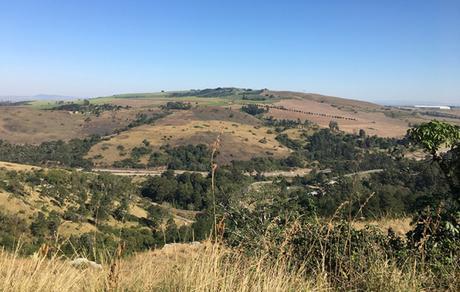
View from the other side of Inchanga, 39 km to go
But Bruce has always been different. In 1981, with South Africa under an international sporting boycott and the race losing some of its luster, he won Comrades for the first time while wearing a black armband to protest the 20th anniversary celebrations of the apartheid government. He’s since called his show of defiance “one of the proudest moments in my life”.
Not surprisingly, Inchanga saddled me with my first 12-minute mile of the day, not counting my mile spent with Katie and Rory. The monster not only ate into my time, but more importantly as it turns out, tackling it with the sun high in a cloudless sky took more out of me than I knew. All hope of my stomach handling solid food for the rest of the race was gone, and I spent the next 3 km of downhill running trying to regroup.
By the time we summited the next short climb I was dragging, another chewed-up-and-spit-out victim of Inchanga’s wrath. So the timing was perfect to pass the Ethembeni School for the Physically Disabled and Visually Impaired.
At the expo two days earlier we’d stopped by the Ethembeni booth, made a donation and chatted with the headmaster who’d been manning the booth. And he’d given me a beaded bracelet created by the students to show their support for the runners. The bracelet, he explained, comprised 87 beads grouped by color (black, blue, white and yellow), one bead for each km of the Comrades route. Not only that, but the number of beads in each colored grouping represented the number of km between each cutoff point along the course, with larger black beads separating the different groups to signify each cutoff point, as well as the start/finish line. A clever and meaningful design.
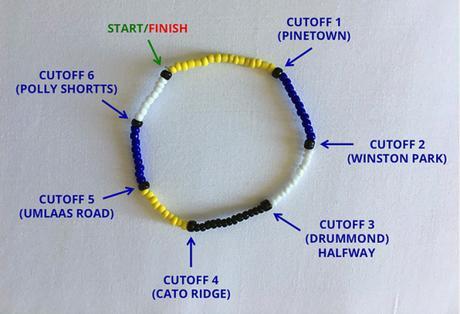
My race-day inspiration from the Ethembeni School
I wore the bracelet now, and seeing the earnest, smiling faces lining the street with tiny hands extended, I felt a surge of adrenaline and swerved to my right, determined not to miss a single high-five. The Ethembeni School was a highlight of my day and a crucial pick-me-up just when I needed it the most. Suck it up healthy guy, stop walking and get going.
The spectators along the course kept me moving forward as well. Comrades spectators are insanely supportive, and not just in a clap-politely-as-the-runners-go-by sort of way. I’ve never run a race where the spectators ask, in all seriousness, “What can I get you? What do you need?” And though I never took anyone up on their offer, I got the sense that some folks, if I’d asked, would have dragged a mattress out of their house and cooked lunch for me while I slept.
It’s something you have to experience for yourself to understand: 92 years strong, Comrades is inextricably woven into the fabric of the nation. South Africans embrace their national race with a passion, a pride and an intelligence I haven’t seen anywhere else, with the possible exception of Boston.
And speaking of intelligence, I was starting to doubt mine. We were now out in the countryside (i.e. No Man’s Land) between urban centers, the winter sun beating down on us, my stomach rejecting all my nutritional advances and the walk breaks getting longer and more frequent.
I was now snagging two water satchels at each aid station—one I’d sip from and then pour down my back while holding onto the other like a security blanket. I appreciated the satchels because they were easy to carry after opening, without spilling. Between the heat and the jostling, though, the water in the satchels warmed up to an unappealing temperature in no time.
Ironically but not surprisingly, the short stretch through Harrison Flats really wasn’t. The name is curious, since “Harrison Hills” has such a nice ring to it and would feel right at home along the Comrades course. I had to assume whoever named it had a wicked sense of humor. Or maybe “flat” is a relative term, with Inchanga on one side and Polly Shortts on the other?
32 km to go.
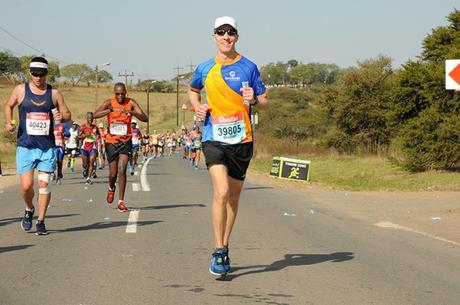
There’s daylight under that there foot! (photo: Jetline Action Photo)
Cato Ridge: When the going gets tough…
My second Katie and Rory sighting couldn’t have come at a better time. With 25 km to go I dropped my hydration pack on the curb and collapsed alongside it for a couple of minutes, sipping some water and gathering my wits. It was good to escape the maelstrom, if only for a moment. The pack had become an albatross, with food I couldn’t eat and Tailwind I couldn’t drink. Plus, my core muscles were tight from carrying it and taking too many shallow breaths. It was time for us to part ways.
A sub-9 bus passed as I sat on the curb, watching the steady stream of runners flow past. Which perked me up, even though I knew a Bill Rowan (sub-9) finish was off the board. As much respect as I have for those who run Comrades, I’m even more in awe of those who pace Comrades. As if there weren’t enough stress in finishing your own race (and there is), as a pacer you have to finish 87 km within a certain time, while leading other runners who are putting their race in your hands (and feet). Talk about pressure.
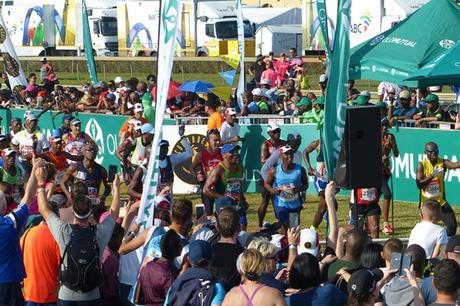
A 9-hour bus (see the yellow “SUB-9:00” sign?) rolls toward the finish in Pietermaritzburg
“You can walk it in from here and still collect a medal, mate,” Rory reassured me. Which actually was reassuring, though also motivating since I had no intention of walking it in. Sub-10 remained my goal, though I knew the next 25 km would be my slowest of the day.
I took a couple of deep breaths, told Katie and Rory I’d see them at the finish, and rejoined the flow as spectators on both sides of the road screamed their approval. Immediately I enjoyed the benefits of discarding the pack: my core relaxed, and the water I poured down my back cooled me more efficiently as my shirt was able to move in the breeze. And as with the first time I’d seen them I enjoyed a surge of energy, clocking my first sub-10-minute mile in over an hour.
Let’s just call what came next the “Beatdown in Camperdown”. Luckily the smell of the local chicken farm wasn’t as strong as I’d anticipated, and in fact wasn’t nearly as off-putting as the secondhand smoke from the occasional outdoor grill along the course, the thick haze hanging in the air and impossible to avoid.
Based on Norrie Williamson’s course analysis, these should have been the “CRUISE” miles of the up run—the relatively level stretch during which strategic runners, having tackled the first half of the race conservatively, now shift into cruise control, run comfortably and make up time. This sunny outlook, however, fails to take into account the real sunniness: the cumulative effects of the African sun (even a winter sun) on a cloudless day. With temperatures reaching into the 80s, heat exposure and a recalcitrant stomach replaced uphill climbing as the primary culprits of my mounting fatigue.
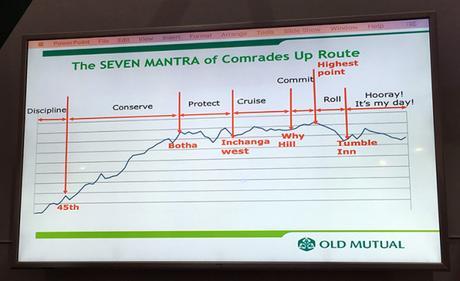
Norrie Williamson‘s 7 stages of the Comrades up run, from the pre-race expo
“NO WALKING BY MY HOUSE” read one fellow’s handmade sign, arguably the highlight of Camperdown. I saw few memorable spectator signs at Comrades, though admittedly my brain was in standby mode for about the last 40K. I do remember the sign promising that “ZUMA FLATTENED POLLYS” (referring to South African President Jacob Zuma and the last of the Big Five, Polly Shortts). And the woman with the “YOU = AWESOME” sign seemed to be everywhere; I saw her at least three times on the course.
Shuffling along slowly but surely with 23 km to go, I heard a familiar voice behind me: “Hey there, stranger.” I glanced back as fellow Stanford alum John from Anchorage pulled up alongside me. John and I had run the densely packed Durban Parkrun as a shakeout session the morning before, chatting comfortably and taking our time. As happy as I was to see him now, though, this wasn’t good news. John had qualified for Boston with a marathon time in the low 3-hour range, and he’d set a goal of a sub-8:30 finish for Comrades.
Turns out Comrades is no Parkrun. Apparently John had started strong and run smoothly up until the-hill-that-must-not-be-named (ok, Inchanga), where his calves had seized up. Since that point he’d been reduced to walking much of the course, with frequent stops at the medical tents for a roadside massage. We ran and walked together for a couple of km, and I was hoping we’d be able to hang with each other to the finish.
But it wasn’t to be. At one point I turned to say something and… John had disappeared. I glanced behind me but, not seeing him, I assumed he’d stopped for more treatment. Silently I wished him a speedy recovery and pushed forward, one slow-footed step at a time.
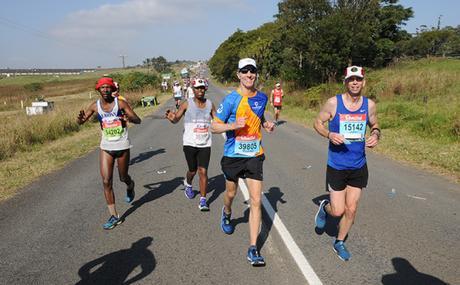
Joined by comrade John from Anchorage (right), 23 km to go (photo: Jetline Action Photo)
John was by no means alone. As the miles piled up, the medical tents kept increasingly busy. Cramping and exhausted runners stopped for treatment, some settling for having their legs sprayed with a topical analgesic to numb the pain. My buddy Gil saw one runner asleep under a tree. For these folks the goal was to reach the finish line in Pietermaritzburg, by any means necessary.
Luckily, as tired as I was, I wasn’t cramping and I wasn’t hurting physically. And unless I have a bone sticking out of my leg, I want to be able to feel everything that’s going on in my body during a race. So I bypassed the menthol mist clouds and kept pushing forward.
The stretch from Inchanga to Polly Shortts felt interminable, like a blog post with no end in sight. Had some prankster moved the km markers farther apart? Every km now felt like a mile and every uphill required some degree of walking, which I tried to avoid on the downhills.
I now followed the same pattern at every aid station: two waters and either a cup of Coke or a satchel of Energade. Sometimes I’d try both in a desperate attempt to appease my stubborn body. Like a junkie craving his next fix, I was chasing the sugar dragon from one Coke to the next, one Energade to the next, trying to find some form of easy fuel to keep me going. And never with much success.
Luckily I’d been training my body for several months to run well on its own fat stores as fuel, so this wasn’t a “sugar or bust” situation. But it sure would have helped. Meanwhile, I carried an unopened water satchel with me between aid stations, as though fearful I might burst into flames at any moment. Rarely did I drink it—it was almost instantly warm, after all—but instead dropped it into the ice bin at the next aid station.
And about those aid stations: without a doubt, the volunteers at Comrades are some of the best in the world. The demands on these folks are unrelenting, with a job description that includes standing out in the heat for hours at a time, a steady stream of insatiable zombies bearing down on them with arms outstretched and hands open in anticipation. And yet every volunteer carried out their assignment masterfully, with grace, aplomb and always an encouraging or helpful word. All damn day, without even a medal to show for their efforts.
The Ultimate Human Race owes its success and reputation, in large part, to the ultimate race volunteers.
With my mind searching vainly for its happy place, I thought about Coach Lindsey Parry’s suggested mantras for this stage of the race: “Tired but strong.” “Uncomfortable but strong.” “Challenged but strong.” In each case, he was half right.
21 km to go.

Parked cars line the exit ramp in Camperdown
Catching the bus: Gunning for Polly Shortts
Passing the “21 km to go” sign, I felt my first sense of relief that yes, the end was in sight. A half marathon was a very runnable distance, never mind the fact I had nearly 25% of the course still to run. A long 25%.
“Cold cream soda!” offered an aid station volunteer. Still in search of a friendly sugar kick I accepted his offer, willing to overlook the fact that the liquid was bright green. One sip later, I knew I’d made a poor decision.
Likewise with water. This is tough to imagine if you’re not a runner—and maybe even for most runners—but thanks to the heat, my body had reached the point where even water had somehow lost its appeal. Not unless it was ice-cold and cascading down my back.
By the time we reached the course’s highest point at Umlaas Rd (2,700 ft, 17 km to go), I was racking up 11-minute miles like mosquito bites in the jungle. The landscape on either side of us remained decidedly rural, the countryside rudely interrupted by the occasional transformer tower. Here the fifth cutoff mat awaited, another small step toward victory in our inextricable march toward Pietermaritzburg.
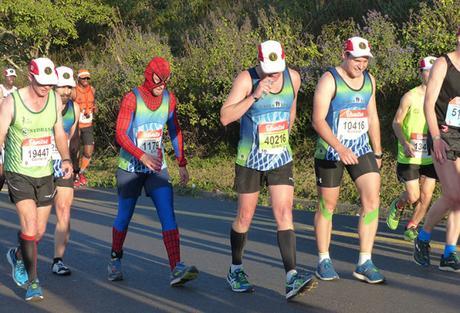
Comrades tests the hero in all of us
Crossing under the N3 for the final time, I saw a sign that in my frazzled state made me want to laugh and cry in the same breath. “← N3 Durban” it read, pointing back in the direction we’d come. Not right now, thank you.
Somewhere in the hot, nondescript and seemingly interminable stretch between Inchanga and Polly Shortts, the muscles around my heart began to tighten. I guessed this was due to my taking short, gasping breaths rather than deep productive ones, and I slowed my pace even more to try to regulate my breathing and ease the discomfort. I’ll run through myriad aches and pains without complaint—most runners will—but the one organ that’s off-limits is the heart. Any discomfort in or around my chest, and I start listening to my body bigly.
The tightness around my chest reduced me to a power shuffle, though fortunately the discomfort would fade after several slow, deep breaths. From there the tightness would come and go the rest of the way, slowing me to a fast walk with each appearance. It’s possible I could have powered through it, but why risk it? I had no intention of doing anything stupid (says the guy running 87 km in 80+ degree heat) to jeopardize my reaching the finish.
Would now be a good time to mention I run to stay healthy?
Polly Shortts may be the last of the Big Five, but try telling that to its protective sister, Little Pollys. At nearly 2 km in length Little Pollys is decidedly shorter than its big sister, and yet 76 km into the race it definitely leaves an impression. Luckily I knew it was coming and so had primed myself mentally, even as I was breaking down physically.
Little Pollys is the perfect example of one of the up run’s nasty unsung hills. Like any ultramarathon, Comrades will punish you psychologically if you let it. On the other hand, take the time to study the course and appreciate the potential landmines beyond just the Big Five, and you’ll win half the battle before you ever leave Durban. Knowledge is power. Respect the hills, don’t fear the hills.
Cruising through Ashburton with about 10 km to go, the 10-hour bus caught and passed me. It was an impressive size, a creature of almost military precision, its leader regularly barking out start and stop commands to his attentive tribe. At that point I had a painful decision to make, and I made it quickly. It wouldn’t be easy, it wouldn’t be comfortable, and it would require me to empty the tank and then some—but ten hours was the limit of what I was willing to concede. It was time to dig deep and do whatever needed to be done to stay ahead of the 10-hour hopefuls. Seizing the opportunity I leapfrogged the group on their next walk break, extending my lead as we approached the last celebrity obstacle between us and glory: Polly Shortts.
10 km to go.
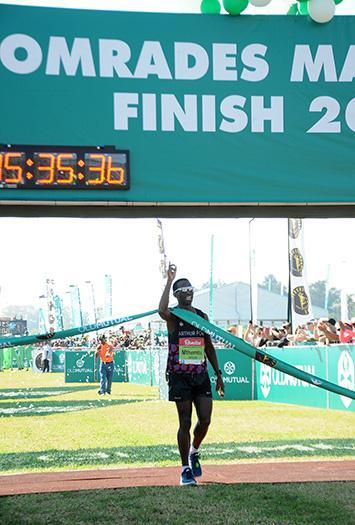
Bongmusa Mthembu wins the 2017 Comrades Marathon (photo: Jetline Action Photo)
Polly Shortts to Scottsville Racecourse (finish)
PinkDrive, an organization similar to Planned Parenthood in the U.S., had set up their inflatable pink arch and high-energy aid station at the base of Polly Shortts, providing runners with much-needed hydration and momentum for the final big climb of the day.
Sticking to my script I grabbed water and Energade satchels—for liquid courage, if nothing else. Then I launched myself up Pollys, intending to follow Rory’s advice to run four cat’s eyes and walk two. Unfortunately many of the cat’s eyes were missing, and so I was forced to improvise on the steep grade, running where I could and walking where I couldn’t. All the while I remained keenly aware of the 10-hour bus in my rearview mirror.
Polly’s may be steep, she may be the last serious speed bump on the way to Pietermaritzburg, but for runners who attack her smartly she comes too late to inflict a fatal blow. Like a Venus flytrap, however, she lies in wait for slower victims, devouring those who fail to reach her summit—and the course’s final cutoff point—within 11 hours and ten minutes.
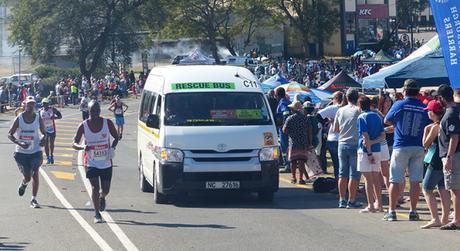
Luckily I steered clear of the famous (and infamous) rescue bus, which awaits runners who miss a cutoff
Late in the race even the spectators seemed to grow quiet, as though unsure how to respond to the zombie death march they were witnessing. Running an entire km at a time felt like a major victory. Each time I stopped to walk I would feel my bladder control waning and think That’s it, I’m not going to be able to start running again. And yet somehow each time I was able to pick up my feet and pick up the pace, while gradually extending my lead over the 10-hour bus.
I’d stopped Garmin-gazing hours before, and the bus was my only clue that a 10-hour finish was still within reach. As long as it was on pace…
One oversight I didn’t understand was the lack of aid stations after the 83 km mark. I really could’ve used at least one more, and I’m sure I wasn’t alone. Those last 4 km were infinite enough without constantly scanning for the next aid station that never appeared.
Damn, was I glad these were km and not mile markers.
One last overpass and we entered the residential neighborhoods of Scottsville. One fellow offered us a beer while another stood in the road, his garden hose trained on passing runners. I veered toward the latter, the cold water hitting me squarely in the face for an invigorating pick-me-up that would propel me to the finish.
Passing the “1 km to go” sign I flipped the mental switch tiredly into “victory lap” mode, knowing much of that final km would be run inside the stadium. Sure enough, moments later I glanced up to see the Scottsville Racecourse welcoming me home, its shaded entrance tunnel like the gaping, defanged mouth of the beast I’d come to vanquish. I entered the stadium like a conquering hero returning home from battle—though not before the course played its final sadistic hand, a quick downhill-then-uphill jag into the stadium and onto the grass track.
Slowly I followed the curve of the track, conflicting emotions gripping my head and heart. As much as my mind wanted to bask in the moment and savor its once-in-a-lifetime significance, my body was good and ready to be done. Where’s the finish arch? Two turns later, it finally came into view in all its bright red glor—.
I sensed it almost instantly, a wave of WTF? washing over me. Something about the scene wasn’t right. A moment later I realized what was up: the arch was too small; there was too much open space beyond it. And the runners ahead of me weren’t stopping.
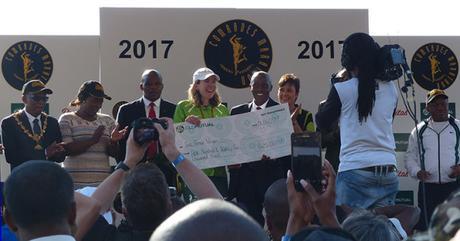
Women’s champ Camille Herron of Oklahoma accepts a giant check for her giant effort
Turns out this Trojan Horse of a finish arch was actually a spectator bridge set up to allow finishers after the race to cross over from one side of the stadium to the other. And I wasn’t the only one to mistake it for the real thing. Apparently Camille Herron, the women’s winner, stopped running and started celebrating after crossing under the bridge, nearly giving race officials and horrified spectators a collective heart attack before a fellow runner urged her on to the finish. Herron’s near miss evoked memories of last year’s Olympic Marathon Trials in Los Angeles, where women’s champion Amy Cragg and men’s third-place finisher Jared Ward each stopped short of the finish before recovering in time to avoid an historic blunder.
Luckily I didn’t have much time to ponder the indecency of this deception. One final turn and there it was, directly ahead of me and as vivid, as beautiful as anything I’d ever seen. What immediately caught my eye were the four words I’d been chasing for nearly ten hours: COMRADES MARATHON FINISH 2017.
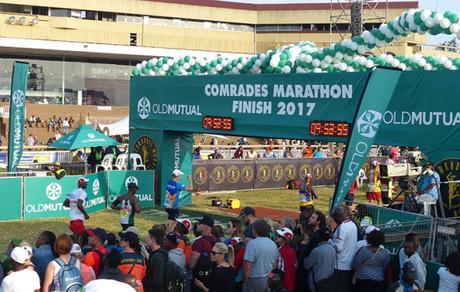
Sub-10 hours!
The green finish arch stood larger than life, dressed for the occasion in green & white balloons and ready to accept me into the Comrades family. Me. Hardly the heroic paradigm for a Mad Max movie or a Cormac McCarthy novel, by no means an elite athlete or desert warrior, and endowed with unbronzeable skin that efficiently converts the sun’s rays into an unsightly sunburn. I was on the verge of joining Bart Yasso and so many others as one of the few, the proud—the freaks!
Spectator-filled bleachers lined each side of the home stretch, and tiredly I shot a thumbs-up in the air as I heard a female voice—though not Katie, whose own voice was still recovering from strep throat—yell my name. I assumed in the moment this was directed at me, since unlike the U.S. every third male in South Africa isn’t named “Mike.” And I’d discover later the voice belonged to Anchorage John’s wife Rochene, who’d been tracking my progress all day.
I wish I could remember my thoughts as I pumped my fists and crossed under the finish arch in a triumphant 9:52:55. Wish I had something poetic and profound to share, shimmering words that would punctuate the most amazing day I’ve ever spent on a race course. Honestly, though, with my mind and body running on fumes, I’m pretty sure my analysis in that shining moment went something like, Me done big race.
I crossed the finish line and stopped—I can stop! And just stand here! And there I stood for a moment, luxuriating in my lack of forward progress. I tried to gather my thoughts, only to find my brain deliciously devoid of gatherable thoughts. Then I shuffled forward through the finish chute, basking in the moment, clinging to it as though it were a newborn child.
0 km to go.
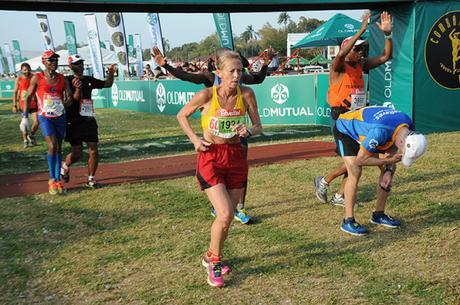
Some pictures are worth more than 1,000 words (photo: Jetline Action Photo)
Izokuthoba: It will humble you
Volunteers presented me with a Comrades logo patch, yellow rose and bronze finisher’s medal, the latter in recognition of a sub-11-hour finish.
The Comrades medal is arguably the most coveted in all of racing; ironically it may also be the smallest, at roughly the size of an American quarter. But as someone who’s been around the block galaxy a few times once said, “Size matters not”. It’s not the size of the medal you earn, it’s the size of the mettle that earned it. And if I were to clear out my wall at home to make room for just one medal, Comrades would be it. Though admittedly, if push came to shove, I may just weld my Boston and Comrades medals together and hang them as one.
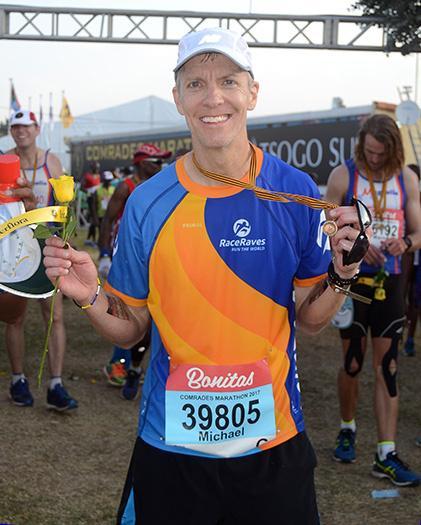
“YOU get a rose! YOU get a rose! YOU get a rose!” (photo: Jetline Action Photo)
I emerged from the finish chute to see Katie and Rory waiting, faces beaming as though they’d both run the last 87 km with me. And for all intents and purposes they had. Because no one conquers Comrades alone. Without Rory’s selfless generosity and Katie’s unwavering support, my first Comrades would not have been the apex of my running career.
Immediately I dropped to one knee and presented Katie with the rose, thanking her for sticking by my side through another unforgettable adventure. Little did she realize this seemingly heartfelt gesture was my worn-out way of asking her to hold the flower for me while I rested.
The three of us exchanged hugs and I proudly showed off what Bruce Fordyce calls the “limp of pride,” slowly following Katie and Rory to the field o’ finishers. The scene resembled a MASH unit with exhausted bodies reclining, slumped over and sprawled out across the grass. Wow, that looks comfy, I thought with real envy as EMTs carried away on flexible stretchers the spent bodies of fellow finishers, most of them looking tired but comfortable. On any other day that would be a ride I’d avoid, but today…
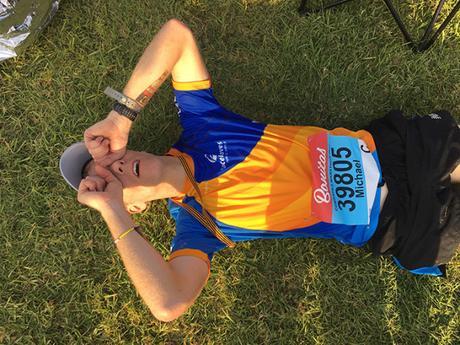
Clearly the heat had taken its toll, with post-race accounts of debilitating leg cramps, gastrointestinal distress and finish-line collapses requiring IV intervention. Roughly 2.6% of the field (~440 runners) were treated in the medical tent, most for dehydration. According to one fellow finisher who ended up in the hospital for a post-race IV (and who highly recommended it), the attending physicians there treated 17 Comrades finishers as Code Reds, meaning life-or-death situations. Luckily the story has a happy ending, as all finishers eventually left the hospital under their own power. The official medical statistics for the day can be found HERE.
I lay on my back in the cool grass, ankles sticky with dried Energade, blankly staring up at something I’d not seen all day: clouds. Suddenly the sickening stench of cigarette smoke inflamed my nostrils, and bitterly I glanced over to see a non-runner puffing away nearby, seemingly oblivious to what he was doing and where he was doing it. Had I been able to move, I might have recommended he go find a more appropriate place to showcase his nicotine addiction, say maybe an emphysema clinic.
I lay there, trying to get comfortable but with little success. This had happened before, most notably after the 2012 Mt Diablo 50K and 2013 Harding Hustle 50K, both run in scorching heat. My body was so drained and so exhausted that no matter what position I tried—standing, sitting, kneeling, slouching or splayed out on the grass—I couldn’t get comfortable. In hindsight I probably would’ve benefitted from an IV, but barring that I just kept reminding myself, Every minute is another minute closer to being comfortable.
“Fucking Inchanga,” I muttered up at Rory through clenched eyes, playfully acknowledging the validity of his warning. He laughed, pleased to admit another member into the eternal brotherhood of Comrades runners humbled by one mighty hill.
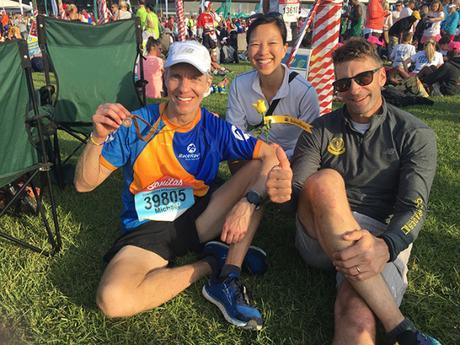
A wave of nausea passed over me and I leaned forward, fertilizing a row of bushes with what little liquid remained in my stomach. As feisty as my stomach can be, it hadn’t turned itself inside-out after a race since the Pikes Peak Ascent in 2010. Immediately I felt better. “Drink up and stay hydrated,” advised another finisher who’d witnessed this unfortunate exchange. I did what I could to heed his advice; my body, however, still refused to cooperate.
That night at dinner I’d discover, to my chagrin, that even my upper palate hurt—you know, that soft tissue in the roof of your mouth that contributes nothing to forward motion? You know you’ve reached a low point when your palate hurts. I could only assume the bruising sensation had something to do with the pressurized jet of cold water and Energade that had been hitting it all day long. Unless someone has a better explanation, which I’d love to hear.
As I lay motionless in the grass like a garden hose, Katie headed toward the international tent to find something for me to drink. There she bumped into John and Rochene. In response to her queries about his well-being, John simply smiled and patted her shoulder. He was too exhausted to speak and too immobilized by his locked-up calves to move. Despite persistent cramping he’d stayed the course and finished in a very respectable 10:26:48, impressive considering the battle he’d waged in the second half of the race. I spoke with a lot of runners after the race whose “A” goals, like mine and John’s, were defeated by the heat and hills (being a first-timer who lives 10,000 miles away didn’t help, either).
And speaking of goals: next time (yes, I said it) I’ll run higher-mileage weeks to train for Comrades. This year, leading up to the Eugene Marathon in May, I’d focused on speed rather than endurance, and had averaged fewer than 40 miles per week in March and April as a result. I wasn’t concerned because I’d intentionally built a strong aerobic base in 2016, but more miles at a slower pace would have been a more race-appropriate training plan.
Finally it was time—I had to move. I wasn’t about to miss the spectacle that is the Comrades 12-hour cutoff. The final moments of the race are broadcast across the country as the entire nation tunes in to watch the human drama unfold. Gingerly I climbed the bleachers, “We Will Rock You” by Queen blasting from the loudspeakers and the uncaring clock ticking up toward 12 hours. Exhausted runners streamed through the finish line now, the crowds resembling a Walmart on Black Friday. A 12-hour bus led its charges home triumphantly.
I don’t recall where I read it, but apparently half of all Comrades finishers cross the line in the final hour.
With the sun having set and the light fading rapidly, so too were the chances of those still out on the course. Europe replaced Queen with “The Final Countdown” as the last few hopefuls circled the stadium in a desperate struggle to reach the finish. The moment was electric, and I felt my whole body—already exhausted from my own struggle—tense up with nervous anticipation. This felt like the Roman Coliseum, and I half expected the PA announcer to bellow, “RELEASE THE LIONS!”
Except that this was more compelling theater. Frantically the hoarse, disembodied voice counted down the closing seconds until, at 12 hours sharp, hope collided with reality and a living, breathing wall of volunteers swung into place, blocking the finish line and denying access to horrified runners just meters from the finish.
And just like that, the 2017 Comrades Marathon was over. All at once, it felt like someone had let the air out of the stadium.
When the dust settled, 13,852 of the 17,031 starters (81% male, 19% female) reached the finish line within the 12-hour time limit, an 81% success rate. Bongmusa Mthembu of South Africa crossed the finish line first in a time of 5:35:34, while Camille Herron of Oklahoma won the women’s division in 6:27:35, becoming the first American champion—man or woman—since Ann Trason in 1997. Three weeks later, Ryan Sandes would turn the tables by becoming the first South African to win America’s most prestigious ultramarathon, the Western States 100-Mile Endurance Run.
But as Norrie Williamson points out, the real heroes of this race aren’t the front-runners or middle-of-the-packers—they’re the 11- and 12-hour warriors who find themselves at a disadvantage before they even cross the start line, and for whom “Every step forward” isn’t advice so much as it is necessity.
The singular charisma of Comrades is evident in the number of runners with more than 10, more than 20, more than 30 finishes. Gil, a fellow SoCal who earned a Bill Rowan medal this year in his first Comrades, is already making plans to return—and not just next year, but for eight more years after that until he earns his own green number. Sure, his may be the most expensive green number in history by the time he’s done… but that’s the seduction of Comrades.
And it’s not just the most successful runners who fall under its spell. At the pre-race reception for international athletes I met one fellow from the UK who’d run Comrades seven times, despite only completing the race three times and never finishing an up run. Yet there he was, gamely preparing for his fourth shot at the up run because, as Ernest Hemingway wrote in The Sun Also Rises, “Isn’t it pretty to think so?”
South Africa, with a population roughly equivalent to California and New York state combined, attracts over 20,000 registrants for its signature event. Which makes me wonder whether an event like Comrades could work here in the states. Surprisingly, there’s nothing like it in the U.S.—sure we have huge marathons like Chicago and New York City, but most of our ultramarathons are run on trails. And our largest 50-miler, the JFK 50 Mile, had a paltry 753 finishers last year. Granted Comrades has 92 years of history on its side, and the JFK 50 (founded 42 years after Comrades) intentionally limits the size of its field to 1,250 entrants. But still—1,250 is a far cry from 20,000.
Many Americans know someone who’s qualified for and/or run the Boston Marathon. Boston is an event that’s held in high regard here, as only the best of the best run it. For South Africans, though, Comrades is a way of life. Across the country, the easiest way to start a conversation is to wear your Comrades gear, or mention that you’ve run the race. Everyone seems connected to the event in some way—either they’ve run it themselves, or have a family member who’s run it, or know someone who’s gotten it done. And everyone has a story to tell. If I ever decide to write a book but feel too lazy to come up with a topic, I can always gather 50 South Africans in a room, turn on the recorder and say “Comrades. GO.” I guarantee what comes out of it will be compelling.
By pure serendipity we had the opportunity to meet another South African legend, controversial sports physiologist, prolific author and Comrades guru Dr. Tim Noakes, on our flight to Cape Town later that week. Dr. Noakes and his wife Marilyn were extremely affable when I introduced myself, and we bonded quickly over my scientific background and first Comrades finish. I was a bit starstruck—after all, his Bible-like tome The Lore of Running occupies a prominent position on our bookshelf at home. And Tim Noakes, along with Bruce Fordyce and golfer Gary Player, is a member of the Holy Trinity of South African sport. So fortuitously bumping into Dr. Noakes was the perfect way to punctuate our first visit to South Africa.
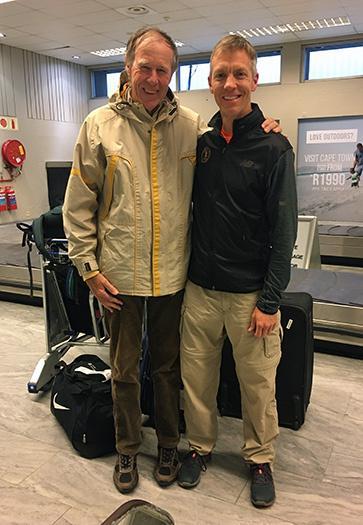
Meeting Tim Noakes in the Cape Town airport
As a recreational runner, there’s no title I’ll wear more proudly than “Comrades finisher”. Something very special happens between Durban and Pietermaritzburg, a personal transformation invisible to the naked eye, and you won’t cross that finish line the same person who started the race. Comrades will challenge you. It will humble you. It will take all you’ve got. It will build you up and break you down, only to build you back up again. It will teach you lessons about yourself that you may or may not want to learn. It’s a raw, uncensored, powerful experience. It’s the Ultimate Human Race. And there’s nothing else like it in the world.
So if you’re a runner, ask yourself: Do I have the mettle to earn this medal? If the answer is yes, then the most rewarding race experience of your life awaits in South Africa. At what other race does crossing the finish line qualify you for a place on its Wall of Honour?
Admittedly, I’m now eyeing the back-to-back medal that second-time finishers receive for running the up and down runs in consecutive years. After all, I may be feeling good about myself, but I’m still subject to the immutable laws of nature.
And what goes up, must come down.
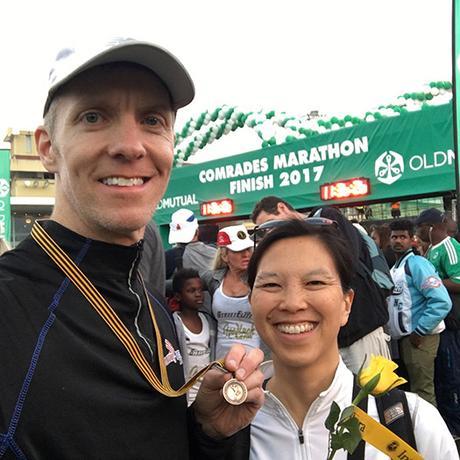
Celebrating the bronze
Survive & Thrive: Eight tips for conquering the Comrades Marathon up run
1) Self-discipline is the key—don’t start too fast. If you find yourself running comfortably in the first few km, you’re probably going too fast.
2) Nothing new on race day—this goes for gear and nutrition. One possible exception is the official Comrades cap you’ll receive at the expo, though I opted against that too.
3) Dial in your nutrition early, before the day heats up and your stomach goes rogue.
4) Don’t underestimate the heat—Much will be made of the 2,500 ft of net climbing in the first half, and for good reason… but don’t discount the beatdown awaiting you courtesy of heat & sun exposure in the second half. International runners, this means you.
5) Focus on your breathing—when the going gets tough, deep breaths with a regular “inhale for 3 steps, exhale for 4 steps” cadence can help you relax and regain a sense of control.
6) Every step forward—if your primary focus is to finish within 12 hours, every step you take should bring you one step closer to the finish. And don’t stop moving at aid stations.
7) Expect the unexpected—e.g. John’s nasty battle with calf cramps—and be ready to adapt.
8) Stay positive—when you’ve got nothing left to give, give a smile (I read that on the sidewalk at the Eugene Marathon).
Comrades Marathon resources I leaned on (in addition to Rory):
- Lindsey Parry’s podcast “RUN with Coach Parry”—especially its archives—is a treasure trove of expertise and insights from the official Comrades coach; older episodes are less than ten minutes each, so you can listen to several at a time. Coach Parry also has some very good content on YouTube.
- Norrie Williamson, 19-time finisher and official course measurer, recently relaunched his website; the current content is a bit outdated, but his Comrades calculator will give you a reliable sense for your projected finish time based on training mileage and recent performances.
- Bruce Fordyce’s blog is another invaluable source of tips & tricks. And though I’ve not read them yet, both volumes of his “Fordyce Diaries”—Conquering the Up as well as Tackling a Down Run—are available as e-books exclusively on the site. If anyone can teach you to conquer Comrades, it’s the man who won it nine times!
- Our friends at Marathon Tours & Travel helped out with logistics, flights and lodging for Comrades and for our post-race travels in South Africa.
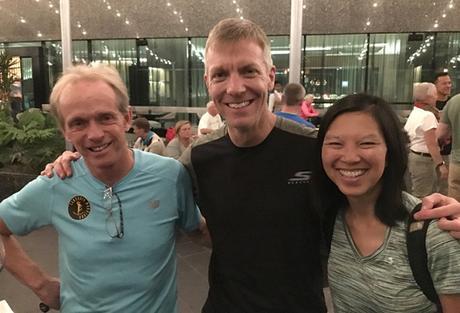
Meeting 9-time Comrades champ Bruce Fordyce at the reception for international runners
BOTTOM LINE: Comrades is like no other running event in the world. It’s an audacious nickname to be sure, but the event lives up to its billing as “The Ultimate Human Race.” I’ve used the phrase “once in a lifetime” twice to describe races: once for the Antarctica Marathon and now for my first Comrades experience. And it’s that experience that keeps its finishers coming back 10, 20, 30, in some cases 40 times. I’d love to return to Boston someday, but I feel compelled to return to Comrades. This race will challenge you, it will inspire you, it will humble you. But most of all, it will change you.
They say you never forget your first. And now I get it.
The name says it all (though not the “Marathon” part, since the race itself is over 50 miles): you don’t run Comrades for the t-shirt and medal, though those are sweet perks. You run for the camaraderie and the community. You run to celebrate the spirit of brotherhood and humanity that unite us all—what the Zulu culture calls ubuntu. You run because there are no strangers between Durban and Pietermaritzburg, only friends you haven’t met yet. And you run to be part of something much bigger than yourself—17,000+ runners from 73 countries, all in pursuit of a common goal, all speaking a common language. The language of Comrades.
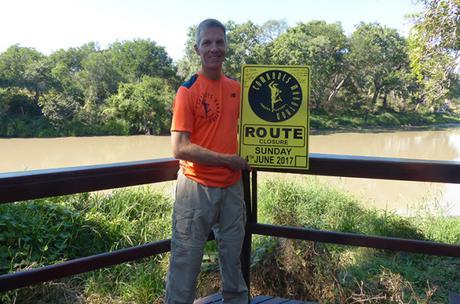
Comrades route closure placard, signed by Bruce Fordyce and Cheryl Winn
Unless you’re among the last-minute finishers or hooked up to an IV in the medical tent, the Comrades experience doesn’t end once you cross the finish line. Watching from the bleachers at the Scottsville Racecourse as the final few finishers struggled to beat the countdown to the 12-hour cutoff was one of the most gripping human dramas I’ve ever witnessed.
For prospective Comrades runners, if you have questions about any aspect of the race I’m sure Rory would be happy to answer them. He’s a fantastic ambassador and a wealth of information on all things Comrades, having crossed the finish line 12 times and earned a green number. Plus, he’s an incredibly generous and genuinely nice guy who knows pretty much everyone involved with the race.
PRODUCTION: Race production was flawless, as evidenced by the start corrals with 17,000 runners all crossing the line within eight minutes. And Comrades wouldn’t be the best race in the world without the best volunteers in the world. From packet pickup to on-course support to the unenviable job of forming a human wall at the 12-hour cutoff, the volunteers are as critical to the success of the race as the runners themselves. The difference being, they don’t take home a medal for their efforts.
The pre-race expo is so large, it even has its own food court. Rows upon rows of exhibitors, retailers, lounges, improvised stages and even massage stations filled the Durban Exhibition Centre. I’d recommend hitting the expo on Thursday or Friday to avoid the Saturday crush, since you don’t want to be on your feet any longer than necessary the day before the race. Separate lounge areas exist for newbies (“novices”), international runners and Green Number Club members to pull up a chair, grab a snack and chat with fellow runners while escaping the crowds. And international runners enjoy another underrated perk at the expo: a dedicated packet pickup line, which saved huge time by allowing me to bypass the Disneyland-length line of South African runners waiting to pick up their own packets. Seriously, the line looked like the wait for Space Mountain. International runners at Comrades are definitely treated like first-class citizens.
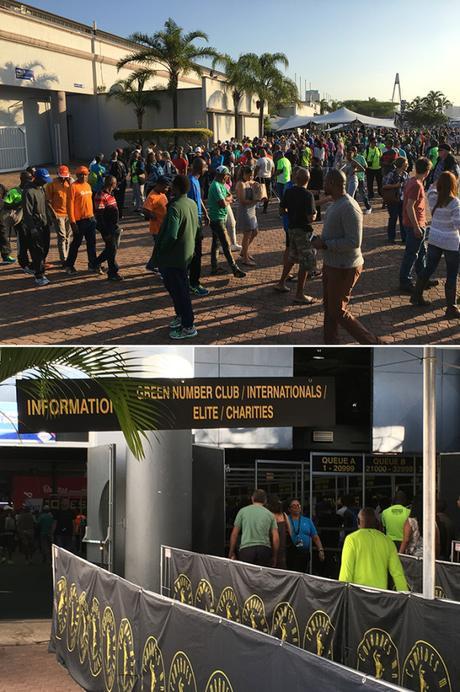
The expo packet pickup lines for South Africans (top) and internationals (bottom)
Speaking of which, Thursday evening also featured a highly recommended reception for international runners at a local hotel. The reception was well worth attending, as we met runners from around the globe as well as 9-time winner Bruce Fordyce and Cheryl Winn, the 1982 women’s winner and current Comrades Marathon Association Vice-Chair. Yet another benefit to being an international runner!
If you have a limited amount of time at the expo, I’d recommend you attend the back-to-back presentations at the Old Mutual tent by Lindsey Parry (the official Comrades coach) and Norrie Williamson (19-time finisher and official course measurer). Each man shares valuable expertise, insights and guidance to help you prepare for race day, along with pace bands that are either free (in Williamson’s case) or which can be purchased for a nominal fee (in Parry’s case, which turned out to be a smart call since Williamson’s bands were quickly snatched up by the “If it’s free, gimme three!” crowd). Coach Parry’s pace bands are temporary tattoos you can affix to your forearm, as I did on race day to track my progress.
SWAG: The smallest medal in road racing may also be the most coveted. With 92 years of history behind it, there’s a singular power and beauty to the quarter-sized medallion on its simple black-and-yellow ribbon. As I said above, it’s not the size of the medal you earn, it’s the size of the mettle that earned it. And when you’re the best in the world, you don’t need to change for anyone. I could go on to gush about the cool race t-shirt and wicking runner’s cap, but that’s hardly going to sway your decision on whether to run the Ultimate Human Race.
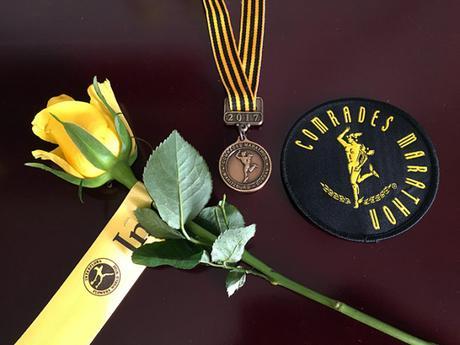
RaceRaves rating:
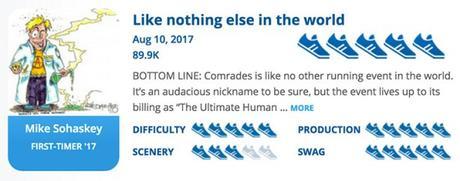
FINAL STATS:
June 4, 2017 (start time 5:30am, sunrise 6:45am)
88 km (54.5 miles) from Durban to Pietermaritzburg, South Africa (Continent #4)
Finish time & pace: 9:52:55 (first time running Comrades), 10:53/mile
Finish place: 4,191 overall, 1,427/4,273 in M 40-49 age group
Number of finishers: 13,852 (11,151 men, 2,699 women)
Race weather: cool & clear at the start (temp 52°F), hot & sunny (low 80s) throughout
Elevation change (Garmin Connect): 5,732 ft ascent, 3,712 ft descent

